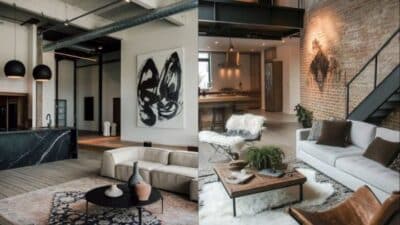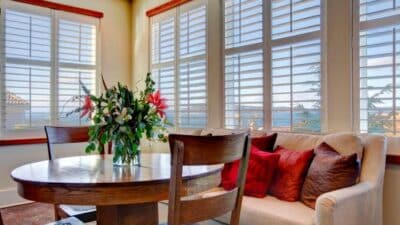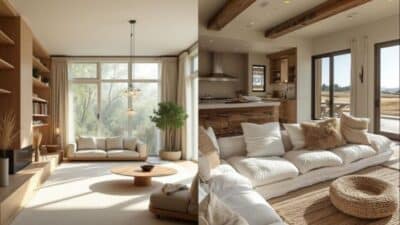Blending Natural Elegance with Modern Functionality.
Why Marble Still Matters in 2025
Marble’s relevance in contemporary kitchen design has only grown stronger in 2025, as homeowners and designers alike continue to favor materials that combine visual impact with natural integrity. Unlike engineered alternatives, marble boasts a heritage of permanence – quarried from rock formations millions of years old and shaped by artisans into surfaces that can define an entire space. According to recent remodeling studies, upscale kitchens incorporating marble consistently retain close to 80 percent of their value at resale. That’s not merely aesthetic appeal – it’s long-term investment power.
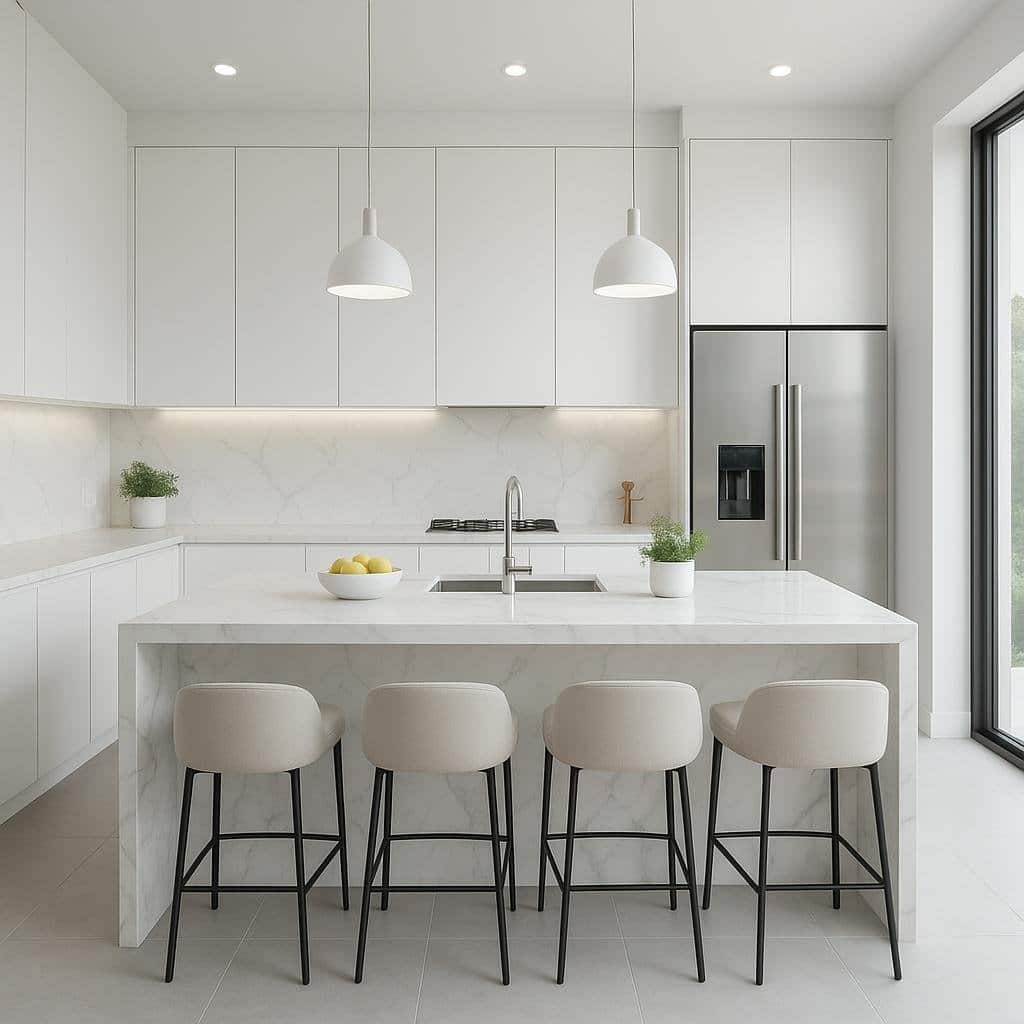
Beyond durability and return on investment, marble resonates with today’s demand for authenticity. Each slab presents a non-replicable story in its veining, movement, and tone. The trend cycle may evolve, but marble remains consistent in its ability to project timeless craftsmanship and understated opulence. As new kitchen styles emerge, the stone’s ability to harmonize with both minimal and maximalist palettes secures its place at the heart of design.
Bold Veining & Dramatic Stone Statements
In 2025, kitchens are embracing visual drama. Arabescato marble, characterized by intense veining and high contrast between creamy whites and graphite tones, has become the focal point in many luxury kitchens. Designers increasingly use bookmatched slabs across large islands and backsplashes to create a mirrored effect that draws attention and emphasizes continuity in natural patterns.
High-impact materials like Calacatta Gold and Nero Marquina are especially in demand among clients looking for contrast-heavy installations. These stones elevate even the simplest cabinetry and lighting setups into cohesive, gallery-worthy compositions. This preference for large-format slabs is also practical – it minimizes grout lines and creates cleaner visuals for open-concept spaces.
| Popular Veined Marbles | Visual Traits | Common Applications |
| Arabescato | Swirling greys and whites | Backsplashes, islands |
| Calacatta Gold | White with gold veining | Countertops, panels |
| Nero Marquina | Black with stark white lines | Feature walls, bar tops |
Textured Finishes: Honed, Leathered & Organic Edges
While high-polish marble still has its place, honed and leathered finishes have gained prominence due to their soft touch and matte appearance. Honed surfaces offer a velvety finish that diffuses light, reduces glare, and feels more approachable in everyday use. Leathered marble, with its slight textural relief, hides fingerprints and water spots – a major advantage in busy households.
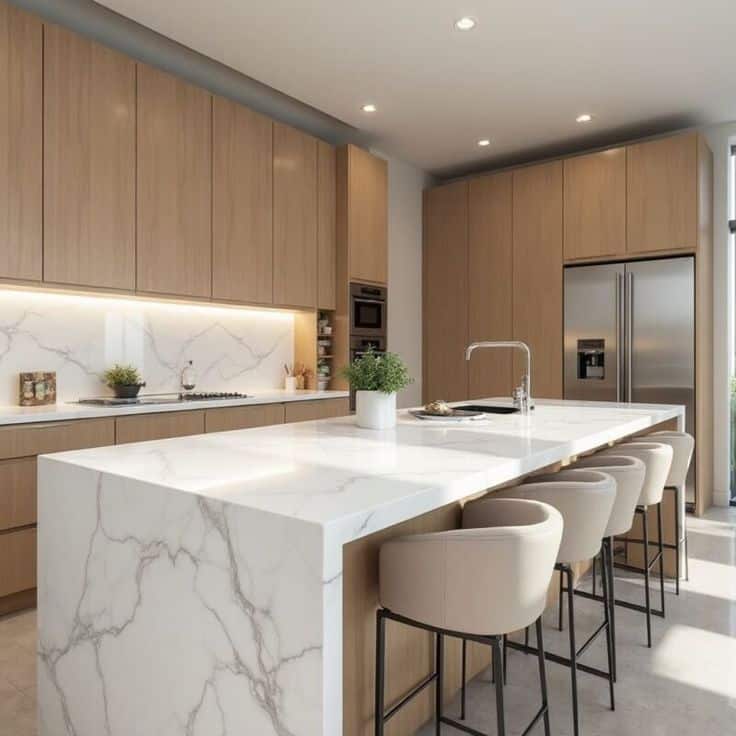
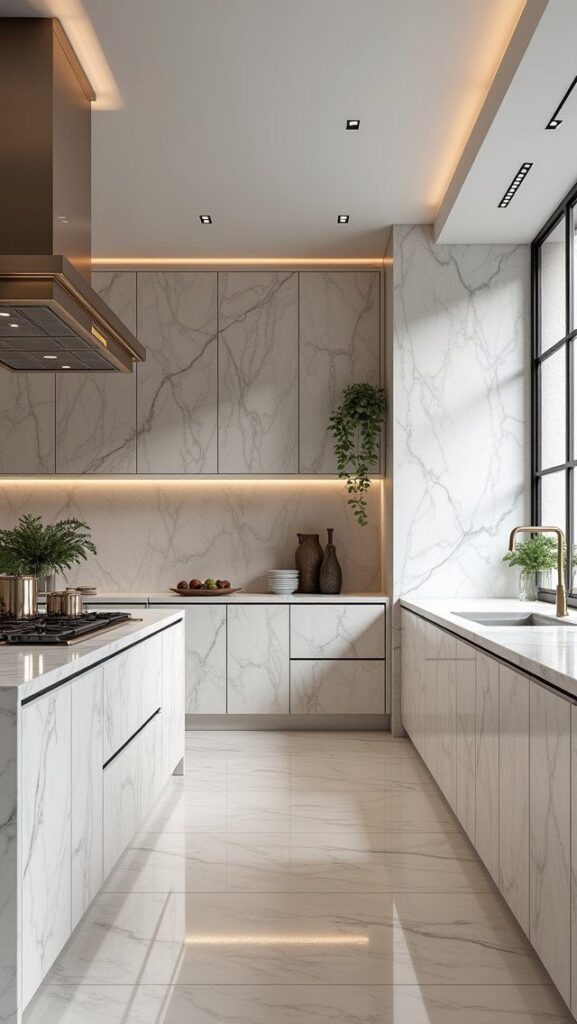
Designers have also shifted toward sculptural edge profiles. Scalloped, beveled, and reeded edges now accompany slab installations, reflecting a move toward tactile expression in kitchen surfaces. These subtle variations deliver a sense of intimacy and craftsmanship often missing in machine-finished surfaces.
Color & Material Pairing in Modern Kitchen Schemes
Current kitchen aesthetics lean toward natural contrasts: deep wood tones, muted matte metals, and layered stone textures. Marble is ideal in these settings for its visual neutrality and ability to reflect ambient tones. Pairing warm walnut or rift oak cabinetry with cool-toned Bianco Carrara or creamy Calacatta Lincoln provides visual balance and depth.
Marble also complements metallics such as unlacquered brass, gunmetal, and polished nickel. Where past designs emphasized stark contrast, 2025 kitchens lean into harmonized layers – marble acting as the grounding agent that ties disparate materials together.
| Material | Pairing Example | Effect |
| Rift oak + Calacatta | Warm wood meets cool veining | Balanced contrast |
| Brass + Statuario | Elegant metallic + soft white | Classic luxury |
| Matte black + Nero Marquina | Dark harmony | Modern minimalism |
Sustainability & Reclaimed Marble in 2025 Kitchens
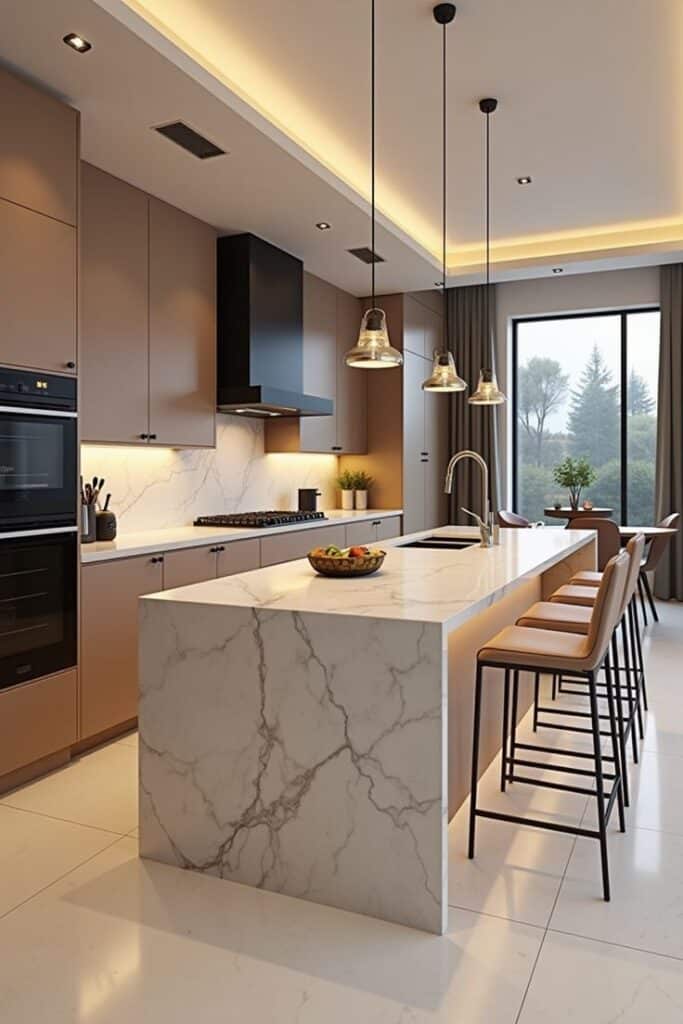
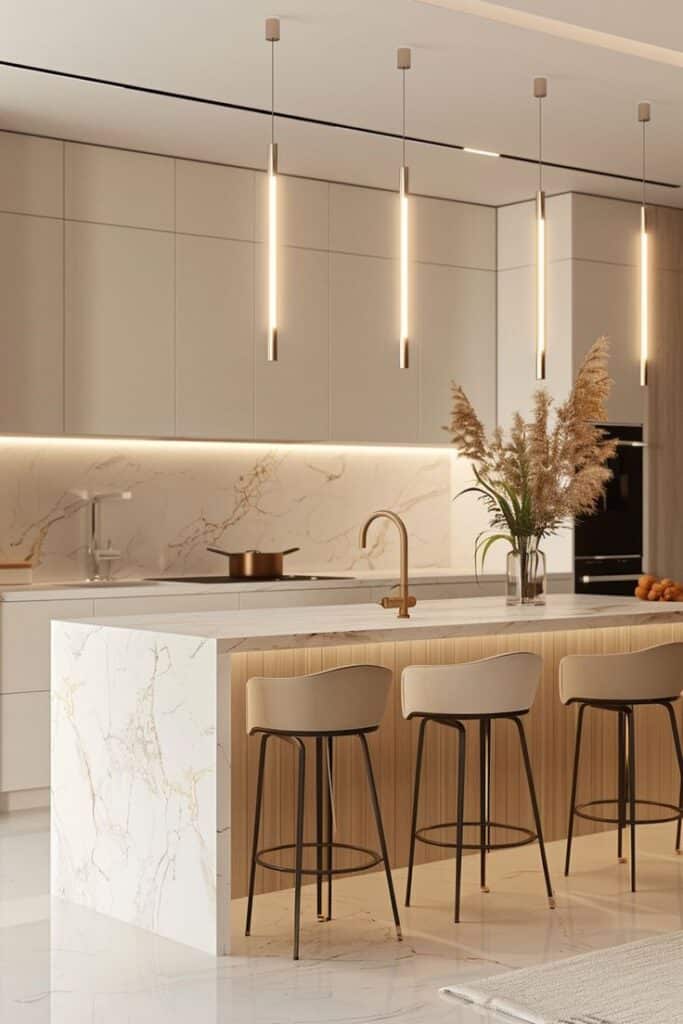
Homeowners are increasingly conscious of environmental impact. Marble, a naturally occurring material with minimal processing, outperforms many engineered counterparts on sustainability metrics. It’s recyclable, VOC-free, and can last for decades with proper care.
Reclaimed marble, once overlooked, is gaining ground. It carries a unique patina that reflects age and history, making it ideal for accent features or restoration projects. Materials such as Verde Alpi or reclaimed Carrara are being salvaged from older buildings and repurposed into countertops and shelving, offering an eco-conscious alternative with historic depth.
Recent studies emphasize that natural stone requires fewer chemicals for cleaning and maintenance compared to resins used in engineered stone products. This aligns well with the health-conscious priorities of readers interested in wellness and clean living.
Marble Longevity: Beauty vs. Practicality
A common question is whether marble can withstand modern kitchen demands. The answer lies in proper placement and maintenance. Marble is not impervious to etching or staining, but its enduring appeal lies in how it gracefully ages – much like leather or hardwood floors. Patina becomes part of its charm.
To balance beauty with function, designers often use marble in lower-impact areas such as islands, wall cladding, or as inset panels paired with durable work surfaces like quartzite or stainless steel. Sealing treatments and neutral pH cleaners make day-to-day care manageable for most households.
UK Marble Suppliers & Their Role in the Trend
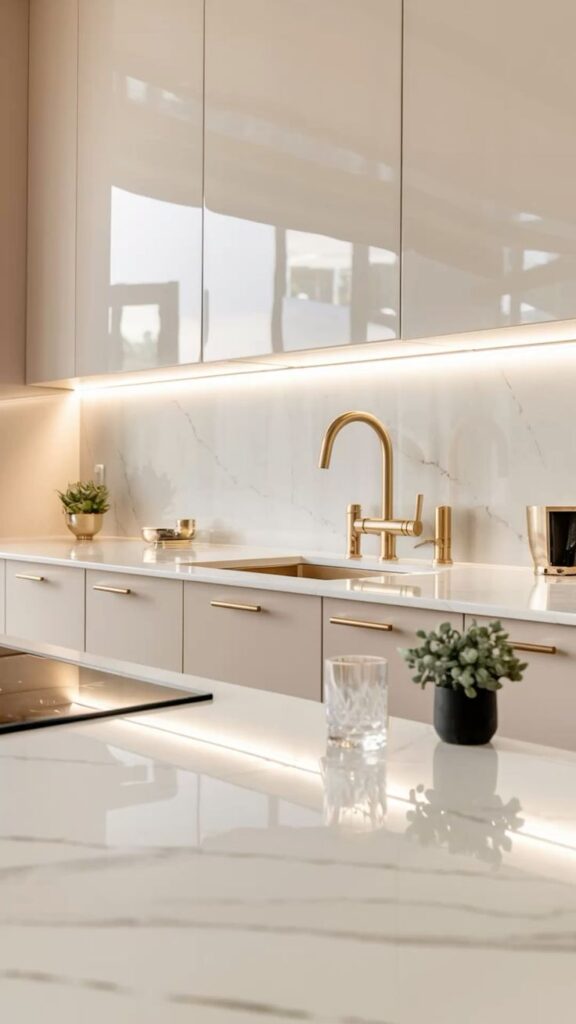
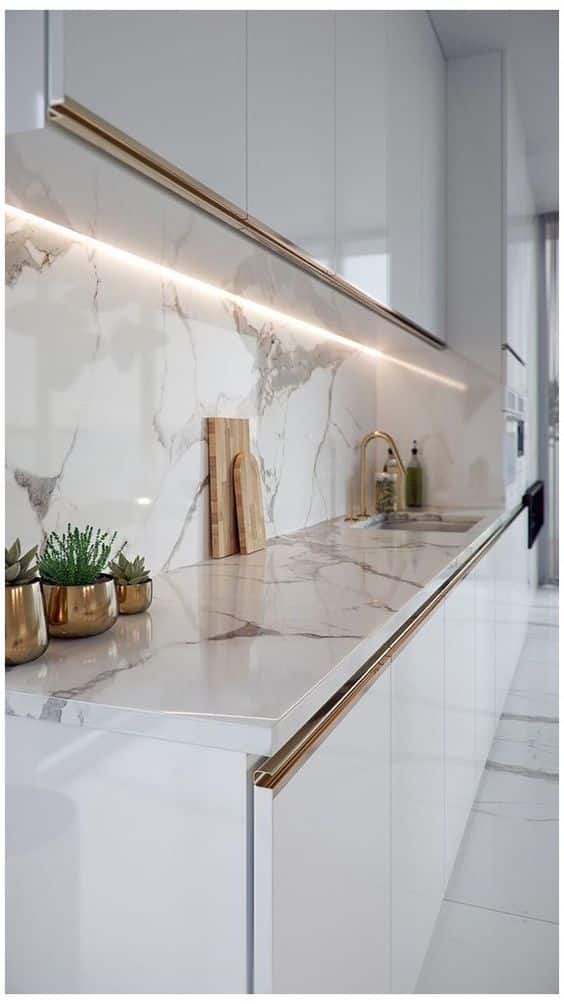
The United Kingdom continues to house some of the most respected names in natural stone sourcing. Emperor Marble stands at the forefront, not only offering a curated selection of European and domestic marbles but also leading in sustainable practices and architectural consulting.
For those sourcing stone in Britain, this marble supplier offers both design flexibility and logistical reliability – an essential combination as renovation timelines become increasingly condensed.
Practical Guidance for Homeowners & Designers
Choosing marble starts with intent. High-traffic households should consider honed finishes and resilient stones such as Dolomite or Serpeggiante. If aesthetic purity is the goal, Carrara or Calacatta remains the go-to for minimalist or classical spaces.
When pairing materials, consider tactile and visual contrast – use soft woods with hard stone, matte fixtures with reflective surfaces. Always request to see full slabs before committing; variations in veining can dramatically affect the final result.
Local sourcing not only reduces environmental impact but also ensures faster turnaround and access to on-site consultation. UK-based stoneyards often provide templating services and allow clients to view slabs before fabrication – a benefit international suppliers can’t always offer.
Elevating Kitchen Design with Marble in 2025
Marble continues to define luxury in a world leaning toward authenticity, sustainability, and craftsmanship. Whether it’s a bold-veined island, a hand-shaped splashback, or a reclaimed slab that tells its own story, marble allows kitchens to transcend utility and become personal sanctuaries.
For health-conscious readers, marble’s natural qualities – free of resins, easy to clean, and naturally antibacterial – make it an appealing material choice. Its unique aesthetic, long-term performance, and sustainability advantages support both well-being and visual harmony in the heart of the home.
In 2025, marble is not just surviving the trend cycle – it’s guiding it.
- 1.7Kshares
- Facebook0
- Pinterest1.7K
- Twitter0
- Reddit0

